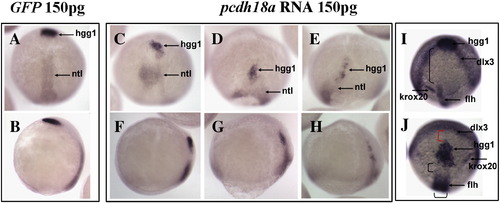Fig. 3
|
Pcdh18a overexpression affects cell movements. Embryos injected with pcdh18a RNA showed delayed epiboly and impaired cell movements. (A?H) In situ hybridization with ntl plus hgg1 in embryos injected with 150 pg GFP RNA (A, B), or 150 pg pcdh18a RNA (C?H, three examples shown). In one of several similar experiments, as 95% (n = 37) of control embryos reached 95% epiboly, the pcdh18a-injected embryos were at about 80% epiboly, had shorter and wider ntl domains, and hgg1-positive cells did not advance normally (60% of embryos, n = 57). (A, C?E) are dorsal views, (B, F?H) are lateral views. (I, J) Anterior views with dorsal to bottom, showing in situ hybridization using probes for hgg1, flh, krox20 and dlx3 for GFP (I), or pcdh18a RNA-injected embryos (J); control embryos were at bud stage. The anterior migration of hgg1-positive cells is delayed, leading to a gap (red parenthesis in panel J) between the hgg1 and dlx3 domains, while the distance from the hgg1 domain to the krox20 and flh domains is reduced (black parenthesis). |
Reprinted from Developmental Biology, 318(2), Aamar, E., and Dawid, I.B., Protocadherin-18a has a role in cell adhesion, behavior and migration in zebrafish development, 335-346, Copyright (2008) with permission from Elsevier. Full text @ Dev. Biol.

